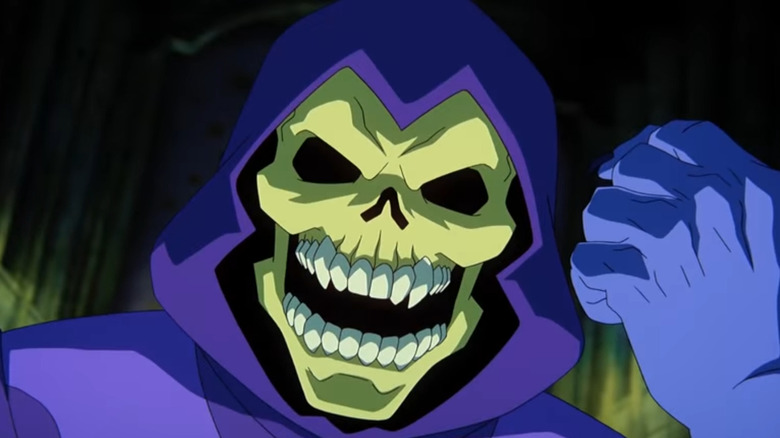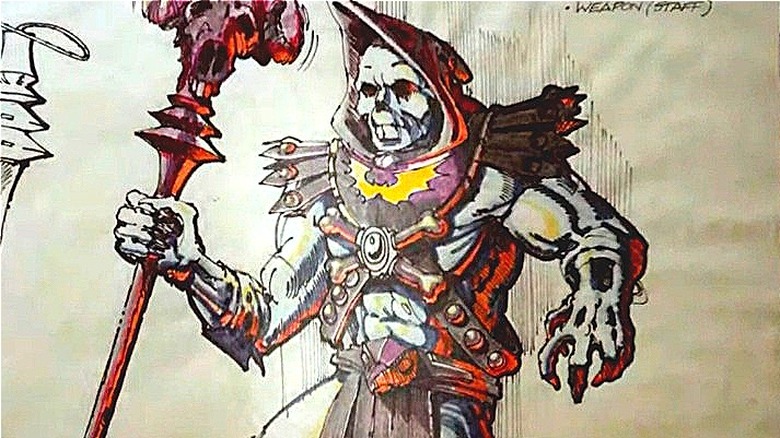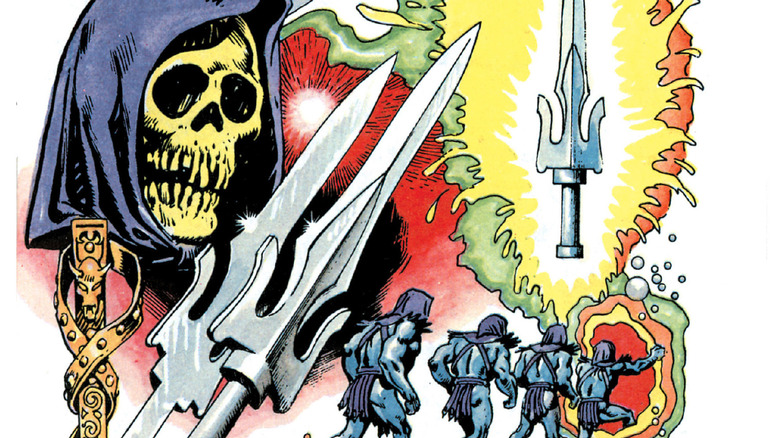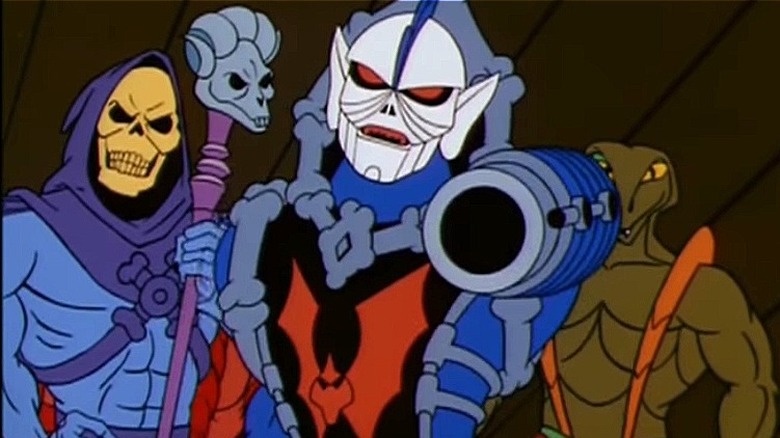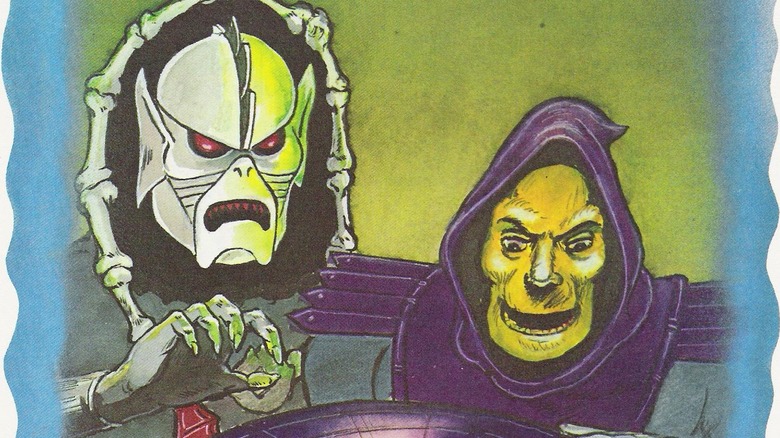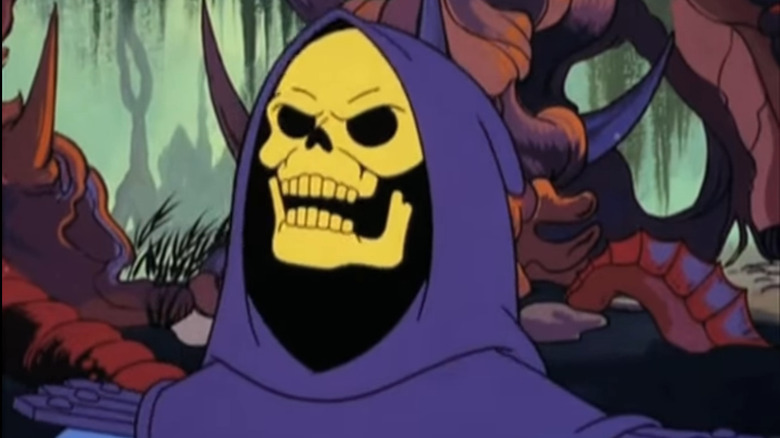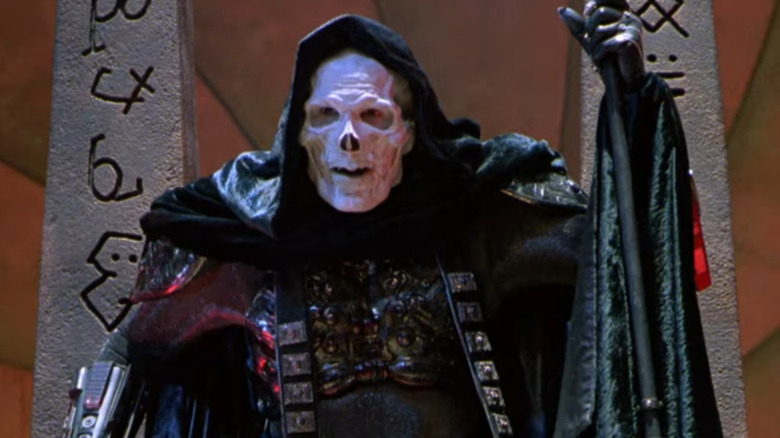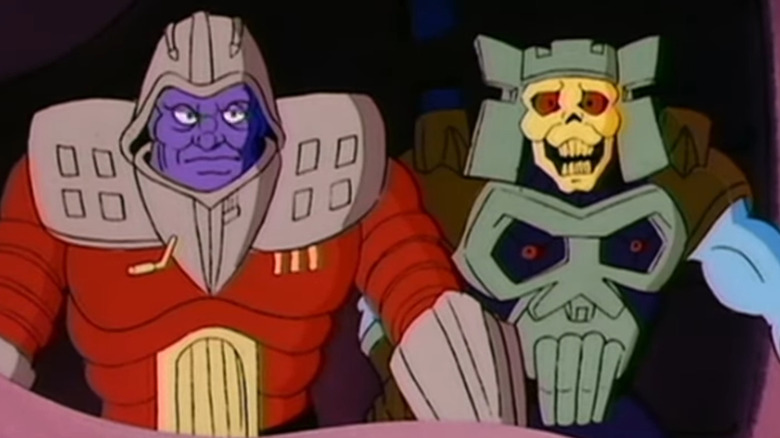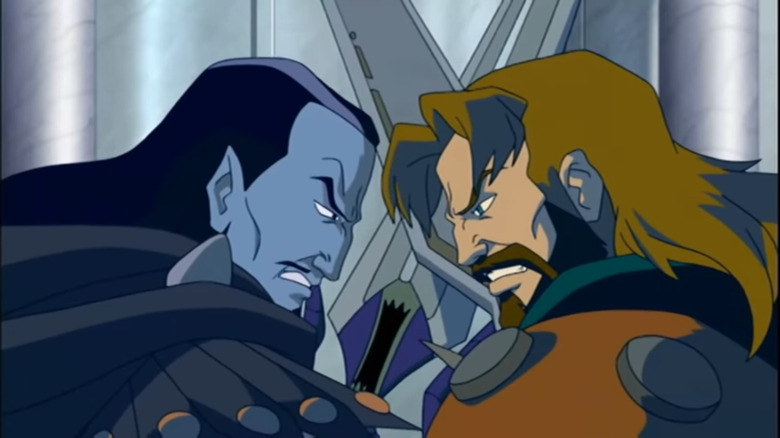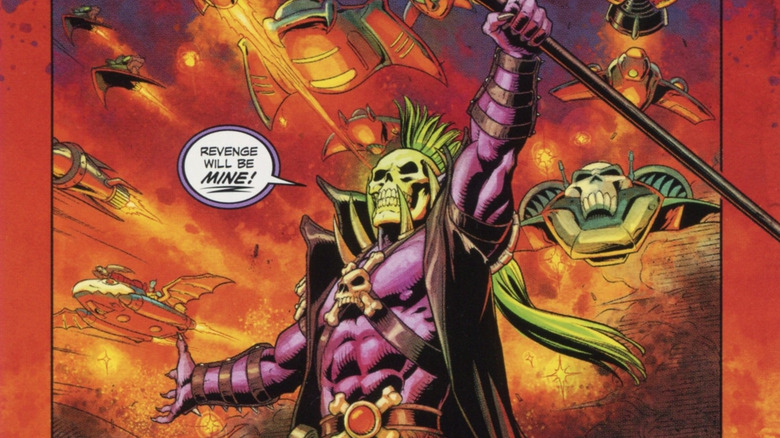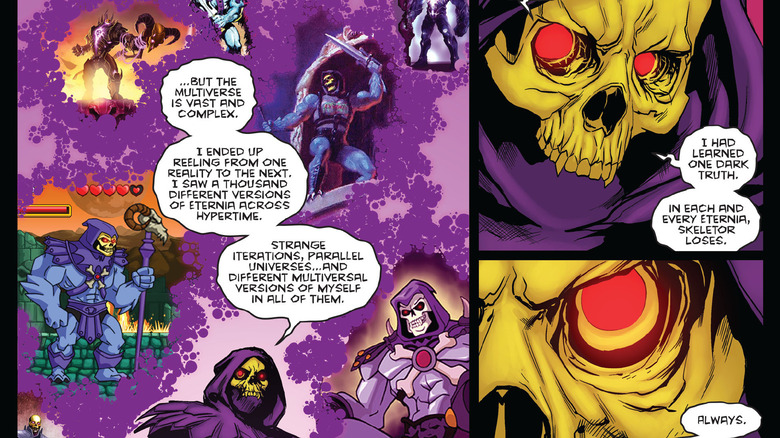The Untold Truth Of Skeletor
Lord of Destruction. Master of Evil. Ruler of Demons. He-Man's arch-nemesis has held many titles, and been through countless incarnations over the years, but one thing's for certain: Skeletor is the type of evil that will never die.
The maniacal horror has been battling He-Man, terrorizing Eternia, and trying to steal the secret power of Castle Grayskull ever since "Masters of the Universe" first burst into existence 40 years ago. He's clashed with He-Man through cartoons, comic books, and records. He has bent his considerable might towards trying to saving a big-screen live-action flop, and has even followed his hated enemy into space and back. Wherever He-Man goes, so goes Skeletor, and that now includes Kevin Smith's new adaptation for Netflix, "Masters of the Universe: Revelation."
But even though Skeletor has been lurking around, plotting in the dark for decades, to many fans he's still a mystery. Who is Skeletor, really? What heart beats within this blue-skinned monster's chest? What memories lay buried in his fleshless skull? And how in the wide universe did a skull-faced monstrosity become one of the most popular children's characters ever created? Every good villain needs a certain amount of mystique — but here are some untold truths that will help you to better understand why Skeletor is and always will be a true lord of evil.
Skeletor was based off an actual corpse
Inspiration can come from a number of places. Sometimes it bubbles up from a creative wellspring within, other times it comes from a dead body seen in a funhouse as a child. You never know until it hits you.
Skeletor's inspiration, though, most definitely came from the latter. According to the Masters of the Universe episode of Netflix's "The Toys That Made Us," former Mattel designer Mark Taylor really did run into a body in the Pike Amusement Park funhouse when he was a kid. Actually, everyone at the park did. Taylor was sure the body was real, but no one else believed him. Then an arm fell off, and the folks at the amusement park realized they'd been scaring kids with an actual corpse.
The corpse in question was once an outlaw named Elmer McCurdy, who'd been killed in a gunfight in 1911. No one claimed him for a burial, so an enterprising undertaker embalmed the body and charged people to see his work. Eventually a carnival man ran off with the corpse, and by the time it ended up in the Pike Amusement Park funhouse no one remembered it was real. Needless to say, that encounter stayed with Mattel's designer, so when it came time to create He-Man's big bad, Taylor drew from his own trauma. His original sketch got toned down a bit — traumatizing kids isn't usually great toy business — but without Elmer McCurdy, we wouldn't have Skeletor.
Skeletor started out as a demonic being
Back when the Masters of the Universe toy line was first released, Mattel didn't have much story in mind for the characters. They created four mini-comics to package with the original toys and explain what was going on, but those early tales bear little resemblance to the world of He-Man that fans grew to know and love.
Mattel's unbelievably extensive "He-Man and the Masters of the Universe: A Character Guide and World Compendium Volume 1" published by Dark Horse Comics refers to this early Skeletor as a "demonic wizard from another dimension." This tracked from how he was originally conceived. In the documentary "The Power of Grayskull: The Definitive History of He-Man," former VP of Marketing at Mattel Paul Cleveland admitted that he'd first thought to dub the villain "D-Man," as in "Demon."
Skeletor helpfully explains in the 1981 mini-comic "He-Man and the Power Sword" that he'd been stranded on Eternia after traveling through a dimensional hole opened during "The Great Wars." He'd come from a dimension populated by "others of his kind," making clear he wasn't human. The comic also suggested that he was ancient. The Great Wars had left Eternia in ruins sometime in the distant past, so Skeletor had been around for awhile. You'd think that would have made him a bit more competent, but that early Skeletor was pretty easily bested by a barbarian with fancy costumes — which is about all He-Man was back in those days.
Skeletor was the pinnacle of evil until She-Ra knocked him down a few pegs
When Skeletor was first created, he was, as designer Mark Taylor shares in "The Toys That Made Us," "the very essence of evil." Filmation's "He-Man and the Masters of the Universe" series bible describes Skeletor as the last remaining ruler of Infinita, Eternia's evil twin planet inhabited with demons and monsters. He was an "evil, megalomaniacal, power-mad monster" determined to conquer Eternia. Admittedly, none of this was ever mentioned on the show, but it was the basis for Skeletor's stories.
Then Mattel launched She-Ra, and for her cartoon debut, they whipped up a being far more powerful and more evil than Skeletor: Hordak.
This villain had been successful in enslaving an entire world –- Eternia's twin planet, Etheria, which had replaced the never-officially-mentioned Infinita. Hordak had even kidnapped a newborn baby — Adora, AKA She-Ra — and brainwashed her into serving in his army, the Horde. What's more, he knew Skeletor not as an equal, but as his one-time apprentice.
Skeletor never managed to conquer an entire world, and the magical power he'd amassed had been learned from Hordak. Granted, "She-Ra: Princess of Power" established that Skeletor's power had grown considerably since his Hordak days, but suddenly this mysterious demonic figure with no real past seemed a bit less intimidating. He'd just been another lackey. A cog in the machine. It was an undermining backstory that has stuck ever since.
Skeletor had almost as many origins as stories about him
Back in the '80s, Mattel didn't have much interest in delving into Skeletor's identity, despite the fact that Masters of the Universe stories were licensed all around the world in every medium imaginable. Comics, picture books, audio plays — He-Man was everywhere.
With this glut of stories came countless origins. According to Kid Stuff's 1983 "Masters of the Universe" record, Skeletor hails from the planet Infinita. In 1988's "Masters of the Universe Magazine" #52 over in the UK, Skeletor is an intergalactic tyrant from Infinita whose "evil was already known throughout the universe" when he was forcibly recruited to serve under Hordak.
In the 1985 Golden Book "The Horde," Hordak tells He-Man the story of a native of Etheria who teamed up with Hordak to learn the secrets of a mineral called "Etheramite." That blue-skinned man was too young to master the mineral, though, and it turned him into a "living skeleton." Meanwhile, over in Germany, they took the whole "essence of evil" thing quite literally. In the 1984 "Masters of the Universe" audio play, "Das Todestar" (The Death Gate), He-Man meets a race of giants who explain that they removed all their evil from themselves and placed it in Skeletor. They then sent him into the time stream and he ended up in modern Eternia. The origins just went on and on, and it took years before Mattel settled on who this living skeleton truly was.
German Skeletor was downright horrifying
With all the different depictions of Skeletor over the years and across the globe, it can be hard to pick one that really stands out. Hard, but not impossible.
Germany really ran with the idea that Skeletor was the pinnacle of evil — real evil. He was the kind of evil that never would have cut it in a U.S. cartoon in the '80s. The German audio portrays the fiend as an all-powerful monster. The Horde and the Snake Men army both served under him, and he successfully conquered Eternia a time or two. Worse, according to Dark Horse's "A Character Guide and World Compendium", this Skeletor "was something of a sadist, taking great joy in imprisoning peasants inside of Snake Mountain and inflicting pain upon others." Plus, he had no qualms about attempting child murder.
Then, there were the comics. Issue #4 of Germany's Interpart-Condo "Masters of the Universe" comics contained a story entitled "Die Macht von Grayskull" (The Power of Grayskull). In it, the Sorceress revealed to He-Man that Skeletor had destroyed the entire flying city of Avion. It had been the home of Stratos' people, the Bird Men — all of his people. Skeletor stole their power of flight mid-air, sending the entire race crashing to the ground in a breathtaking act of genocide. Stratos was the last survivor. Maybe it's a good thing Mattel has backed off Skeletor's supreme evil over the years.
There's a (sort of) scientific reason why Skeletor's cartoon voice was so high
As beloved as Skeletor's portrayal is in Filmation's "He-Man and the Masters of the Universe" cartoon was, fans often have one nagging question about the Master of Evil: How did he get that voice? Shouldn't someone with a literal skull for a head have a terrifying, booming voice? Actually, no. That just wouldn't make sense. Voice actor Alan Oppenheimer has been a vocal master for decades and, as he explained at 2020's GalaxyCon, he based Skeletor's nasally voice off of nothing more than seeing an animation cel of the skull-faced villain.
Our voices are produced from of a mix of sounds from the pharynx in our throats, the nasal cavities in our skulls, and the oral cavities in our mouths. If Skeletor was a skull without the proper vocal apparatuses — and that's certainly all he seems to be — his voice should be less mix and more skull.
"I got the idea for a bony voice because of the bony head," said Oppenheimer. "So I just made it nasal [switching to Skeletor's voice] up in here." Skeletor's unforgettable laugh, though, was a bit less intentional. "It was in an early session," Oppenheimer said, "and I probably laughed embarrassedly and it stayed in and became iconic."
Frank Langella wrote most of Skeletor's dialogue himself in the live-action film
Though a critical and commercial bomb, 1987's "Masters of the Universe" live action film did have a few bright spots, one of which was Frank Langella's portrayal of Skeletor. That was mainly thanks to the storied actor himself taking a hand in the production.
Langella bluntly told Vanity Fair that he had a number of issues with the film and that "it was a terrible script, just awful, but I couldn't resist the challenge of trying to make [Skeletor] real and believable." Plus, his four-year-old son was a huge fan of the Lord of Destruction. So as a devoted dad, he had to bring his boy's favorite character to life.
Langella worked extensively with director Gary Goddard to rewrite most of Skeletor's dialogue, ad-libbing as he went, and pulling inspiration from writers like Joseph Campbell and his work "The Hero With a Thousand Faces." That's how he ended up with some surprisingly deep, memorable lines like, "Tell me about the loneliness of good, He-Man. Is it equal to the loneliness of evil?"
In the years since, some people (obviously not Skeletor fans) have asked Langella and why he took the part — but the actor has said he looks back on the film with genuine fondness.
"Many, many people have said over the years: 'How could you do that?' with a great deal of superiority," he recalled in 2020. "I think it's one of my best performances. I loved doing it."
Skeletor got a facelift and became a space mutant
As the '80s ended and He-Man fever began to fade, Mattel was eager to find a way to keep their cash cow going. The Filmation cartoon was finished, and the toys just weren't selling anymore, so they decided it was time to restart (almost) from scratch. The brand was too good to give up, but it needed a new style, a new story and some new characters. So, they jettisoned He-Man into the future and out into space in "The New Adventures of He-Man." Only three characters made the jump from the original series: He-Man, a telepathically linked Sorceress, and Skeletor ... well, sort of.
He was supposedly the same character — "The New Adventures" was a direct sequel to "He-Man and the Masters of the Universe" — but this Skeletor was almost nothing like the maniacally laughing ruler of Snake Mountain. He preferred to manipulate, rather than rule outright, working as second-in-command to the dimwitted leader of the Evil Mutants, Flogg. Plus, his iconic voice was gone, replaced with richer, smoother tones. On top of that, his face looked far less skeletal, and for the first time, he had eyeballs. Mattel, it seemed, brought along the name recognition, but not much else.
Unsurprisingly, few people remember this short-lived series, and now that "Masters of the Universe: Revelation" is to be the official sequel to Filmation's original cartoon, it seems "The New Adventures" will be remembered as little more than a bizarre footnote.
Skeletor is actually He-Man's half-uncle, Prince Keldor
For years Mattel resisted giving Skeletor a genuine origin, but back in 1986, one of the last mini-comics packaged with the toys contained a story called "The Search for Keldor." In it, King Randor searches for his long-lost brother, Prince Keldor. Skeletor gets wind of the search and is desperate to stop it, saying that it'll ruin him. He succeeds, and we never learn anything more.
The toy line ended shortly after, and the mini-comics with it. Comics writer Steve Grant explained in an interview with He-Man.org that Keldor was supposed to be Skeletor — but Mattel never really planned on revealing it.
Then the 2002 cartoon reboot, "He-Man and the Masters of the Universe," began by establishing that before he became the Skeletor we all know and love, He-Man's arch-nemesis had been a warlord named Keldor. His face was maimed by acid while he was attacking He-Man's father, Randor. If the show had continued, producer Ian Richter told fans that Keldor would have been revealed to be Randor's half-brother.
It didn't continue, but the cat was finally out of the bag, and the idea stuck. For 2008's Masters of the Universe Classics toy line, fans got both a Skeletor toy and a Keldor toy, with the box art backing up the family connection. When DC Comics began their 2012 series run, they kept the Keldor angle too. It took a few decades, but Skeletor finally got his origin.
Skeletor has a secret son with Evil-Lyn named Skeleteen
Before Mattel settled on "The New Adventures of He-Man" as the official Filmation sequel, they looked at a few other ideas to continue the line. When Masters of the Universe Classics brand manager Scott Neitlich revealed a proposed series bible centered around He-Man's son He-Ro and Skeletor's son Skeleteen from back in the late '80s, he blew fan's minds with a series they never knew almost existed.
The proposal was eventually adapted into "The New Adventures," only for the sons idea to resurface again in the '90s with a new series bible for a proposed show with DIC Entertainment. That didn't happen either, and the next generation was dropped for another decade.
In 2008, Mattel started their Masters of the Universe Classics line of toys, releasing every character they could think of with updated backstories unified in a series of comics. Evil-Lyn's packaging curiously mentions her having a secret son with Skeletor back when he was Keldor. Then, in 2014's mini-comic, "The Fall of Eternia, Part One: Homecoming" written by Neitlich, we finally get our first glimpse of that Son of Skeletor, Skeleteen.
After a few massive battles, the series ends with Skeleteen vowing revenge against He-Ro and promising to continue the battle of good and evil. But while virtually everyone from He-Man's son, to his ancestors, to the personification of Castle Grayskull has been given a toy at this point, poor Skeleteen is still nowhere to be seen.
All of these different versions of Skeletor exist in the same multiverse
If there's one thing comic book writers love, it's a good jaunt around the multiverse. Since 2012, DC Comics have been publishing Masters of the Universe comics, so the laws of comic books dictated that at some point the franchise had to cross over with the main DC Universe. About a year into their run, Skeletor made the jump over to Earth to battle the Justice League in 2013's "DC Universe Vs. Masters of the Universe" mini-series, then returned to Eternia for 2015's "He-Man: Eternity War" #5. He'd been gone for some time because, he reveals, he'd been bouncing around Eternia's multiverse, running into thousands of variations of himself.
As he explained where he'd been, the page showed a fascinating array of original artwork, from the first mini-comics and box art to the 2002 He-Man reboot. It even included a picture of the original toy. Whether DC's Skeletor was meant to be some sort of definitive version or that designation is held by one of the others wasn't clear.
But one thing was: All those versions of Skeletor still exist somewhere out there in the multiverse. They aren't just abandoned attempts to flesh out He-Man's fleshless nemesis, but are individual characters in individual worlds, waiting, just like Filmation's version, to be revisited in the future.
